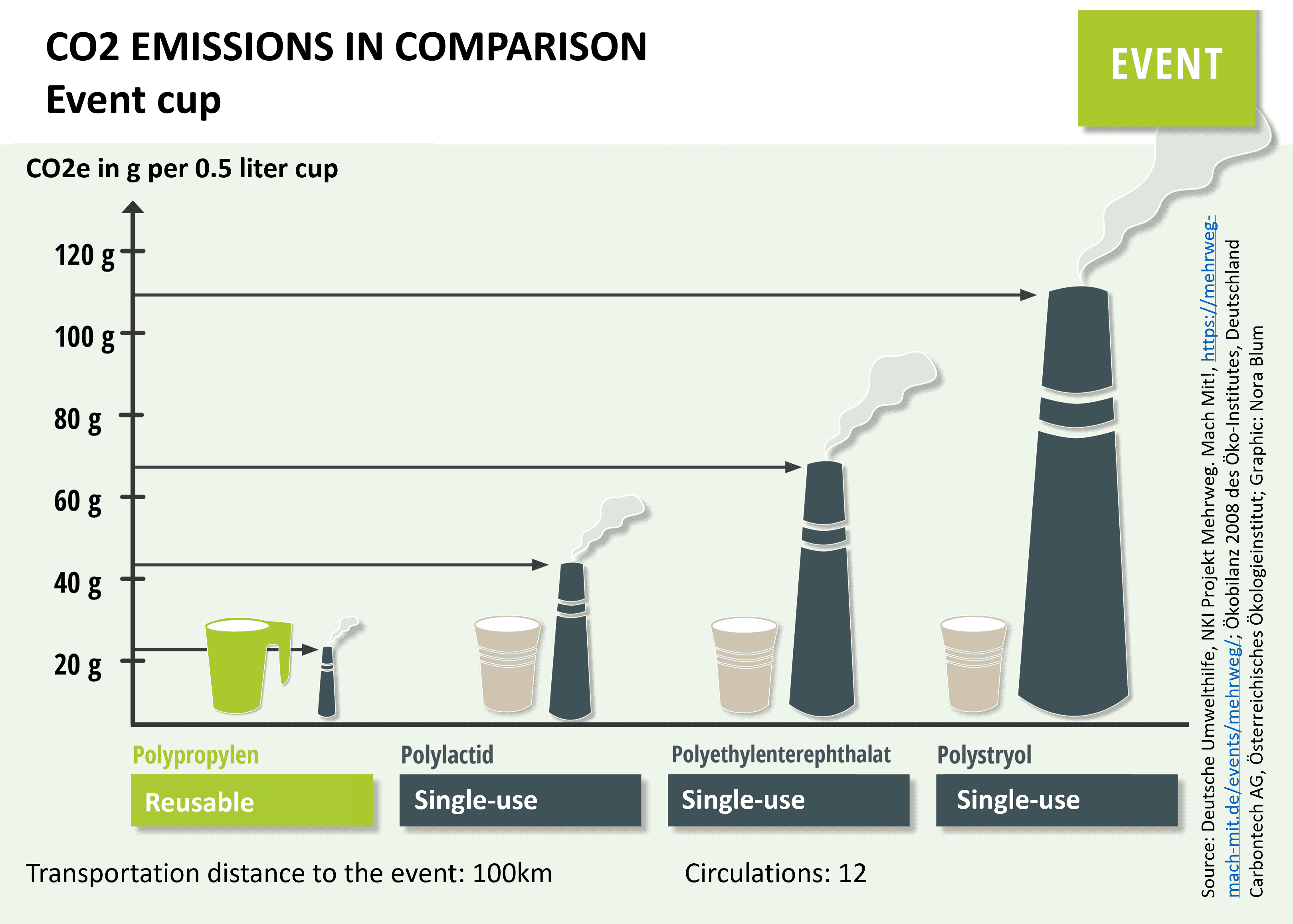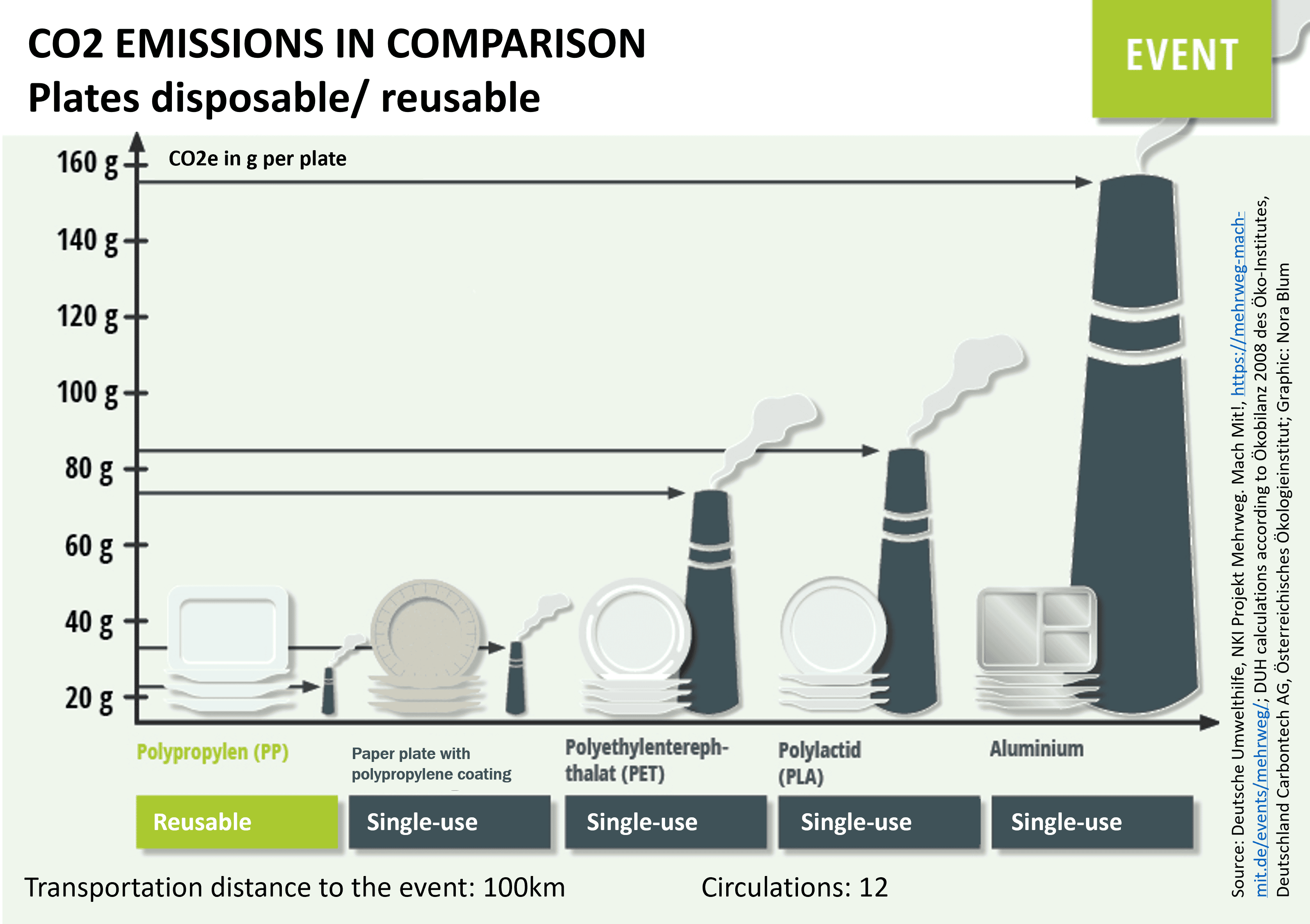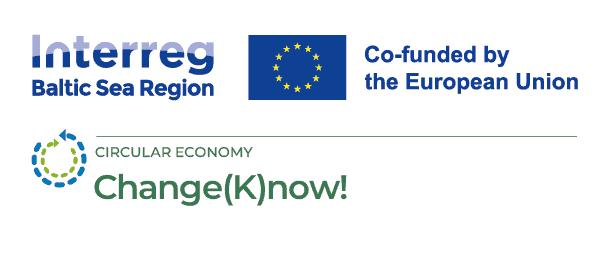
Reusable packaging makes the difference
05 July 2024
In the catering sector – including events – the amount of disposable packaging is enormous and this is a significant environmental problem. At events, a large proportion of waste can be avoided by reducing the amount of disposable tableware.
Here we provide you with further information on why disposable tableware is problematic and why you can make an important contribution to avoiding waste avoidance at events by using reusable systems.
Some facts
- Disposable tableware causes up to six times more CO2 emissions than reusable dishes.
- 100 liters of water and 1.4 kilowatts of electricity are enough to wash 1000 reusable cups. However, producing 1000 cups from PET alone consumes 350 kilowatts of electricity.
- Reusable cups are worthwhile after the fifth use, reusable plate from the twelfth time.
Why “sustainable” disposable tableware is not the solution
Disposable tableware causes a lot of garbage: food and drinks sold at events are often served in disposable containers. The amounts of waste generated at events alone are enormous. And it does not always end up in the waste bins. As a rule, it can be found on the entire event site, sometimes beyond. Only used for a few minutes, it then has to be disposed of at great expense.
Disposable tableware is rarely recycled: At events, it is sometimes challenging to separate waste consistently, which is why the possibility of recycling is greatly reduced. Disposable tableware then ends up in the residual waste and can therefore no longer be recycled. If there are coarse food residues on the plates, recycling is no longer possible. However, even disposable tableware made from renewable raw materials such as wood, bamboo or maize can no longer be recycled – once disposed of in residual waste. Instead, it reaches incinerators via the residual waste. It is then neither composted nor recycled.
Disposable tableware has a poor carbon footprint: Overall, disposable tableware causes at least twice as many CO2 emissions as reusable. On the one hand, this is due to the large amounts of waste that are generated and rarely recycled. Disposable tableware also requires a lot of raw materials, energy and chemicals for its production. These are considerably higher than the resources needed to clean reusable tableware. The ecological benefits of reusable tableware have been proven by life cycle assessments. Just five fillings, for example, can be enough to make a reusable cup the most climate-friendly choice for serving drinks. Reusable polypropylene plates are the more climate-friendly choice after 12 reuses. With each reuse, production and disposal have less of an impact on the carbon footprint.
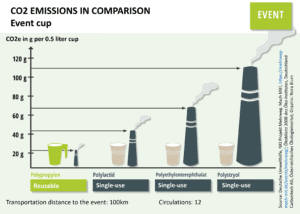
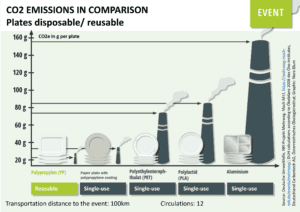
[See below the images in high resolution]
(Source of the 1st image: Deutsche Umwelthilfe, NKI Projekt Mehrweg. Mach Mit!, https://mehrweg-mach-mit.de/events/mehrweg/; Ökobilanz 2008 des Öko-Institutes, Germany Carbontech AG, Österreichisches Ökologieinstitut; Graphic: Nora Blum)
(Source of the 2nd image: Deutsche Umwelthilfe, NKI Project Reusable. Mach Mit!, https://mehrweg-mach-mit.de/events/mehrweg/; DUH calculations according to Ökobilanz 2008 des Öko-Institutes, Germany Carbontech AG, Österreichisches Ökologieinstitut; Graphic: Nora Blum)
Aluminum trays have a particularly poor carbon footprint: they need to be produced in an extremely energy-intensive manner and their disposal generates environmentally harmful waste.
Alternative disposable tableware
But even disposable dishes made from renewable raw materials cannot keep up with reusable: cutlery and plates made of wood are usually produced from fresh wood, which means that trees have to be felled; the cultivation of bamboo, corn and palm leaves is often used in mono-cultures and with the use of pesticides and fertilizers and is often in competition for the cultivation of food or feed. They are also often connected with long transport routes.
In principle, today’s bio-based plastics do not have a better environmental footprint than conventional plastics. “Bio” plastics contain just as many unknown and sometimes harmful chemicals as conventional plastics, meaning that composting or general “littering” in the environment is associated with risks for people and the environment.
In addition, contrary to some advertising claims, bio-plastics decompose only partially or not at all in nature.
There is currently no material recycling for chemically novel “bio” plastics, as this is not worthwhile.
With reusable to a sustainable circular economy
In gastronomy as well as at events, reusable tableware is a central component of a circular economy. With every cleaning and refilling, it goes back into the cycle, saving resources and energy. Compared to disposable tableware, at least 50% of CO2 emissions are saved. Reusable dishes are usually made of porcelain, plastic or stainless steel. When the item is issued, customers pay a deposit, which they get back when they return it. This creates an incentive to put the dishes back into the cycle.
With reusable pool systems, which are often used at events, the dishes do not have to be returned to the same provider, but can also be returned to a different stand, for example. The dishes are either washed directly at the event or collected and then cleaned; damaged dishes are removed from the cycle and ideally recycled. Of course, your own cup or Tupperware container from home can also be used as reusable tableware.
Reusable tableware is already used successfully at many events in different EU countries. In the coming weeks we will show you best practices and case studies around the Baltic Sea.
[News article based on Green Events Hamburg´s articles on the topic].
Sources:
- Green Events Hamburg
- Ein Jahr Mehrwegangebotspflicht: Was hat sich verändert? (WWF Germany, 2024)
- https://mehrweg-mach-mit.de
- https://www.bund.net/themen/chemie/achtung-plastik/alternative-bioplastik/
